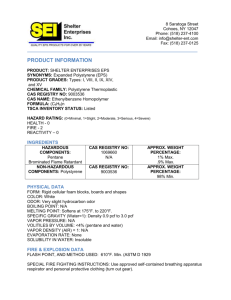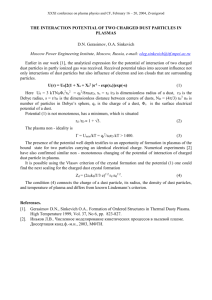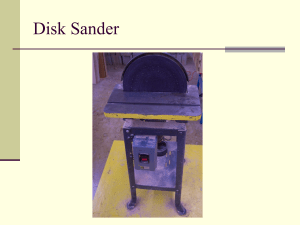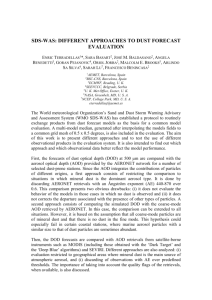Selected properties of spruce dust generated from sanding operations
advertisement
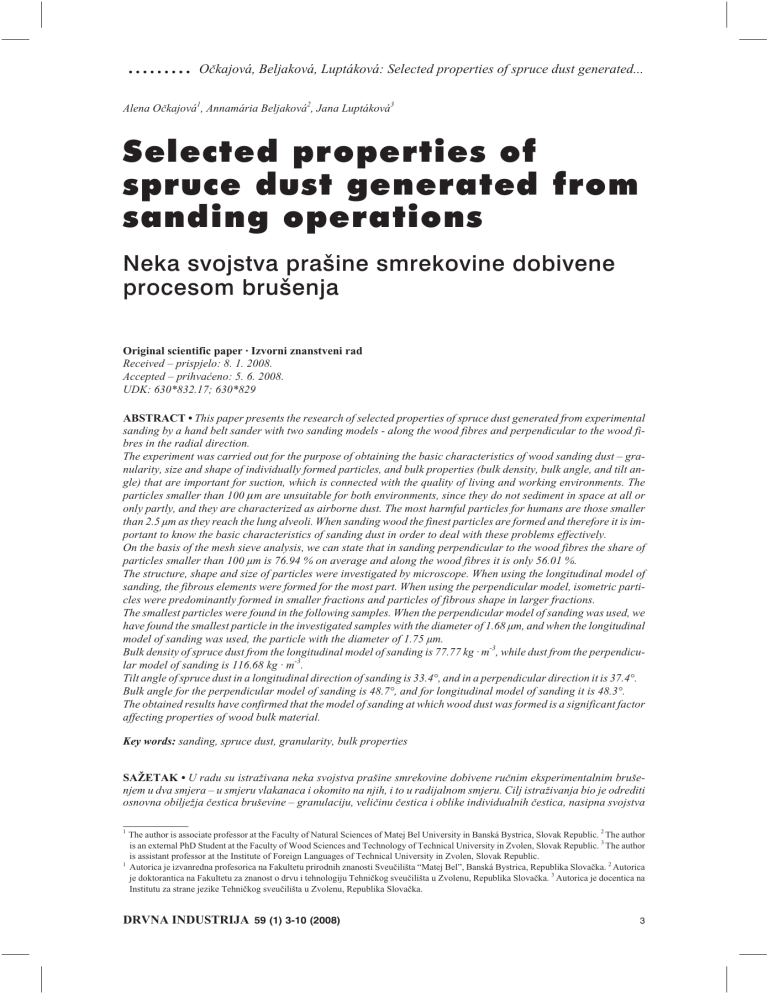
......... O~kajová, Beljaková, Luptáková: Selected properties of spruce dust generated...
Alena O~kajová1, Annamária Beljaková2, Jana Luptáková3
Selected properties of
spruce dust generated from
sanding operations
Neka svojstva pra{ine smrekovine dobivene
procesom bru{enja
Original scientific paper · Izvorni znanstveni rad
Received – prispjelo: 8. 1. 2008.
Accepted – prihva}eno: 5. 6. 2008.
UDK: 630*832.17; 630*829
ABSTRACT • This paper presents the research of selected properties of spruce dust generated from experimental
sanding by a hand belt sander with two sanding models - along the wood fibres and perpendicular to the wood fibres in the radial direction.
The experiment was carried out for the purpose of obtaining the basic characteristics of wood sanding dust – granularity, size and shape of individually formed particles, and bulk properties (bulk density, bulk angle, and tilt angle) that are important for suction, which is connected with the quality of living and working environments. The
particles smaller than 100 mm are unsuitable for both environments, since they do not sediment in space at all or
only partly, and they are characterized as airborne dust. The most harmful particles for humans are those smaller
than 2.5 µm as they reach the lung alveoli. When sanding wood the finest particles are formed and therefore it is important to know the basic characteristics of sanding dust in order to deal with these problems effectively.
On the basis of the mesh sieve analysis, we can state that in sanding perpendicular to the wood fibres the share of
particles smaller than 100 µm is 76.94 % on average and along the wood fibres it is only 56.01 %.
The structure, shape and size of particles were investigated by microscope. When using the longitudinal model of
sanding, the fibrous elements were formed for the most part. When using the perpendicular model, isometric particles were predominantly formed in smaller fractions and particles of fibrous shape in larger fractions.
The smallest particles were found in the following samples. When the perpendicular model of sanding was used, we
have found the smallest particle in the investigated samples with the diameter of 1.68 µm, and when the longitudinal
model of sanding was used, the particle with the diameter of 1.75 µm.
Bulk density of spruce dust from the longitudinal model of sanding is 77.77 kg · m-3, while dust from the perpendicular model of sanding is 116.68 kg · m-3.
Tilt angle of spruce dust in a longitudinal direction of sanding is 33.4°, and in a perpendicular direction it is 37.4°.
Bulk angle for the perpendicular model of sanding is 48.7°, and for longitudinal model of sanding it is 48.3°.
The obtained results have confirmed that the model of sanding at which wood dust was formed is a significant factor
affecting properties of wood bulk material.
Key words: sanding, spruce dust, granularity, bulk properties
SA@ETAK • U radu su istra`ivana neka svojstva pra{ine smrekovine dobivene ru~nim eksperimentalnim bru{enjem u dva smjera – u smjeru vlakanaca i okomito na njih, i to u radijalnom smjeru. Cilj istra`ivanja bio je odrediti
osnovna obilje`ja ~estica bru{evine – granulaciju, veli~inu ~estica i oblike individualnih ~estica, nasipna svojstva
1
The author is associate professor at the Faculty of Natural Sciences of Matej Bel University in Banská Bystrica, Slovak Republic. 2 The author
is an external PhD Student at the Faculty of Wood Sciences and Technology of Technical University in Zvolen, Slovak Republic. 3 The author
is assistant professor at the Institute of Foreign Languages of Technical University in Zvolen, Slovak Republic.
1
Autorica je izvanredna profesorica na Fakultetu prirodnih znanosti Sveu~ili{ta “Matej Bel”, Banská Bystrica, Republika Slova~ka. 2 Autorica
je doktorantica na Fakultetu za znanost o drvu i tehnologiju Tehni~kog sveu~ili{ta u Zvolenu, Republika Slova~ka. 3 Autorica je docentica na
Institutu za strane jezike Tehni~kog sveu~ili{ta u Zvolenu, Republika Slova~ka.
DRVNA INDUSTRIJA 59 (1) 3-10 (2008)
3
O~kajová, Beljaková, Luptáková: Selected properties of spruce dust generated...
.........
(nasipnu gusto}u, nasipni kut i kut klizanja s kosine), koje su va`ne pri njihovu odsisavanju i za njihov utjecaj na
kvalitetu op}ega i radnog okoli{a. Za obje vrste okoli{a {tetno je postojanje ~estica manjih od 100 µm, a s obzirom
na to da se one te{ko talo`e ili se uop}e ne talo`e, smatraju se lebde}im ~esticama. Naj{tetnije ~estice za ljudski organizam jesu one manje od 2,5 µm jer dospijevaju do plu}nih alveola. Uspje{no rje{avanje problema nastajanja
najfinijih ~estica bru{evine mogu}e je uz poznavanje njihovih osnovnih obilje`ja. Granulometrijskom analizom
bru{evine nastale bru{enjem okomito na drvna vlakanca izmjeren je udio od 76,94 % ~estica manjih od 100 µm, a
bru{enjem u smjeru vlakanaca samo 56,01 %. Struktura, oblik i veli~ina ~estica istra`ena je uz pomo} mikroskopa.
Pri bru{enju du` vlakanaca formirani su prete`no vlaknasti elementi. Pri bru{enju okomito na vlakanca uglavnom
su nastajale izometri~ne ~estice u sitnijim frakcijama te ~estice vlaknastog oblika u krupnijim frakcijama. Me|u
~esticama nastalim pri bru{enju okomito na vlakanca izmjeren je najmanji promjer ~estice od 1,68 µm, a pri
bru{enju uzdu`no s vlakancima promjer 1,75 µm. Nasipna gusto}a smrekove bru{evine pri uzdu`nom bru{enju iznosi 77,77 kg/m³, odnosno 116,68 kg/m³ pri bru{enju okomito na vlakanca. Kut klizanja s kosine bru{evine nastale
bru{enjem u smjeru vlakanaca iznosi 33,4°, a kut klizanja bru{evine nastale bru{enjem okomito na vlakanca 37,4°.
Nasipni kut za bru{evinu nastalu bru{enjem okomito na vlakanca iznosi 48,7°, a za bru{evinu nastalu bru{enjem
uzdu`no na vlakanca 48,3°. Dobiveni rezultati potvrdili su da smjer bru{enja s obzirom na smjer vlakanaca ima
zna~ajan utjecaj na veli~inu i svojstva usitnjenoga drvnog materijala.
Klju~ne rije~i: bru{enje, pra{ina smrekovine, granulacija, nasipna svojstva
1 INTRODUCTION
1. UVOD
In the technological processes of machine wood
chipping, a by-product is also formed besides the main
product. These are chips whose shape, dimensions and
quantity dependent on physical and mechanical wood
properties as well as on dimensions of the processed material, type of machine, tool and its geometry, and technical and technological conditions of the process (Lisi~an
et al., 1996). Particles of wood substance formed in individual processes of chipping and machining are called
“bulk wood substance” (Dzurenda, 2007). The nature of
the present production and conditions of chips require
continual removal of chips from the place where they are
formed. As far as sanding dust is concerned, it is removed by means of an air-technical device – suction. To develop an appropriate suction system, it is important to
know the size and shape of bulk substance particles,
which are the basic data for characterizing bulk material.
The above characteristics affect physical and mechanical
properties of bulk substance (bulk density, bulk angle,
tilt angle, aerodynamic properties of particles in the piping of the suction system) and conditions of separation
or filtration in the separating device (Dzurenda, 2007).
The observed characteristics also affect service life of
equipment in the workplace where dust is generated as
well as transportation equipment and filtering elements,
and last but not least safety of the working environment.
Hejma et al. (1981), define fractions smaller than
5 ìm as the fractions which do not sediment almost at
all, they are airborne; the fraction from 5-100 µm sediment slowly and in quite wide surroundings of the place
where they are generated; fractions whose size is over
100 µm sediment in the immediate surroundings of the
place where they are grenerated. Particles whose dimension is smaller than 100 µm are unsuitable for the
living and working environments (Hemmilä and
Gottlõber, 2003) because they do not sediment in the
space or sediment only partly, and they are characterized as airborne dust. The most harmful to humans are
particles smaller than 2.5 mm as they get to lung alveoli
and, according to government regulation, beech and
oak wood dust is classified as carcinogen.
4
In many workplaces, research is focused on issues
of solving the quality of living and working environments
and the results of such research deal with granulometric
composition of wood bulk substance generated from various processes of chipping and processing wood.
The sawing process was investigated from the
viewpoint of risk factors - dustiness, by Dzurenda, et al.
(2005), O~kajová et al. (2006), Banski et al. (2006),
Beljo Lu~i} et al. (2005), Sandak et al. (2006).
Risk factors in the process of plane milling were
studied by Kopecký and Pernica (2004), Barcík et al.
(2007), Kos and Beljo Lu~i} (2004), Beljo Lu~i} et al.
(2007), and in the process of wood turning by Wieloch
and Osajda (2007).
Sanding process as the major source of generation
of airborne dust was investigated by Rogozinski and
Dolny (2004), O~kajová and Beljaková (2004), Beljaková and O~kajová (2007), Ron~ka and O~kajová (2007).
Wood-working enterprises, as sources of air pollution, emit in the air wood dust classified as solid pollutants. Clean Air for Europe is the initiative taken by
the EU Commission, by which one of its main aims was
set in 2002: "To reach such a quality of the environment
where the level of pollutants coming from human activities does not cause any significant impacts and risks
for human health”.
Since detailed characteristics of wood sanding
dust, such as physical and mechanical properties and
information on size (primarily the smallest particles)
and shape of generated particles, are still not known,
the aim of this paper is to give more detailed information on wood sanding dust of spruce.
2 MATERIALS AND METHODS
2. MATERIJALI I METODE
2.1 Preparing the sample
2.1. Priprema uzoraka
The sample of desintegrated wood substance was
prepared by sanding spruce 50x50x50 mm in size with
the density of 446.35 kg · m-3 by two models of sanding:
along the wood fibres (0°) and perpendicular to the
wood fibres in the radial direction (90°), Figure 1.
DRVNA INDUSTRIJA 59 (1) 3-10 (2008)
......... O~kajová, Beljaková, Luptáková: Selected properties of spruce dust generated...
Figure 1 Process of chip creation: a) sanding model perpendicular to the wood fibres, b) sanding model along the wood fibres
Slika 1. Proces nastajanja usitnjene ~estice: a) model bru{enja okomito na smjer vlakanaca, b) model bru{enja paralelno sa smjerom vlakanaca
2.2 Sanding process
2.1. Postupak bru{enja
The experiments were carried out with the equipment for observing the contact phenomena (Siklienka
et al., 1999) whose base was the GBS 100 AE hand belt
sander by Bosch. The LS 309 XH sand belts by
Klingspor were used for the experiments, 100x610 mm
in size and grit size – 80. Sanding was carried out at cutting speed of 7.8 m·s-1 and specific pressure between
the work piece and sand was1.04 N·cm-2.
Sanding dust was caught by the Rowenta vacuum
cleaner in disposable filtering sacks Rowenta Original
ZR 814 (the manufacturer provides no permeability).
Dust sample was filled in plastic sacks, which were closed in order to keep the parameters unchanged. Moisture content of spruce dust for both models of sanding
was 6.00%.
2.3 Granularity
2.3. Granulacija (veli~ina ~estica)
To determine the shares of individual fractions, a
sieving machine AS 200 by Retsch was used with the
set of control stainless sieves with sieve mesh diameters of 0.032; 0.063; 0.08; 0.125; 0.250; 0.5; 1; 2 mm,
and with the following sieving parameters: amplitude
of 2 mm/“g“, interval of 10 s, sieving time of 20 min,
and electronic laboratory scales Radwag WPS 510/C/2
(weighing precision up to 0.001g). Sieving was carried
out three times for each model of sanding. Shares of individual fractions were determined as average values of
measurements.
2.4 Shape of particles and size of the smallest
particles
2.4. Oblik ~estica i veli~ina najmanjih ~estica
The shape and size of individual fraction particles
were observed by microscope in order to specify the
predominant shape in the given interval of particles.
The picture was transferred from the microscope SM1
(maximum enlargement was 400x) directly to the PC
by the camera MoticCam 1000 (1/2" CMOS,1.3 Mega
pixels (1280x1024) by USB 2.0 PC output), where it
was processed by the graphic software Motic Images
Plus 2.0, parameters of the PC - Intel(R), Celeron(R),
CPU 2.4 GHz, 504 MB RAM, the system Microsoft
Windows XP Professional, the graphic adapter Intel
(R) 82845G/GL/GE/PE/GV Graphic controller 64 MB,
Figure 2.
DRVNA INDUSTRIJA 59 (1) 3-10 (2008)
Figure 2 Microscope SM 1 (maximum enlargement of 400x)
with camera MoticCam 1000
Slika 2. Mikroskop SM1 (maksimalnog pove}anja 400 puta)
i kamera MoticCam1000
Ten photos were made for each fraction. To evaluate size and shape of particles, we used the Corel
Draw 11 graphic programme in which the grid produced according to Vo{ahlík and the grid made by 125 µm
and 250 µm distances were transformed. The shape of
particles of each fraction was evaluated from 10 photos
by individual description of particles by the Standard
STN 260070.
The smallest particle size was found among particles observed in the bottom fraction. As the smallest
particles have isometric shape – their two sizes being
approximately equal, the sizes of these ones were evaluated as the diameter of circular outline of particle projection, Figure 3.
Figure 3 Equivalent diameter of particles as a circular outline
of particle projection
Slika 3. Ekvivalentni promjer ~estice projiciran s ~estice sfernog oblika jednakog promjera
5
O~kajová, Beljaková, Luptáková: Selected properties of spruce dust generated...
.........
2.5 Bulk density
2.5. Nasipna gusto}a
Bulk density of sanding wood dust was obtained
by the following steps: the mass of the measuring cylinder was weighed. Then the sawdust sample was poured
into a measuring cylinder 35 cm in height and filled to
the volume of 1.000 ml. After filling 1.000 ml, the sample was again weighed. The above mentioned procedure was repeated 30 times. Based on mass and volume of
the measured sawdust, bulk density was calculated.
The result is an average value.
2.6 Tilt angle
2.6. Kut klizanja s kosine
The measured sample was evenly stratified on the
whole area of the drop leaf (the area of 13.700 mm2) so
that its three raised rims (5 mm) were covered and levelled by the measured sample. The surplus sample was
removed. We slowly tilted the drop leaf. At the moment
when the sample started moving, we stopped tilting,
and we subtracted the tilt angle on the scale in the range
from 0° to 90°, Figure 4. Measurement by Longauer
and Sujová (2000) was repeated 30 times for obtaining
the average value.
Figure 5 Langhaus equipment for measuring bulk angle
1 – loading hopper, 2 – screw for height adjustment, 3 – circular plate f 50 mm, 4 – angle gauge, 5 – measuring rod, 6 – collecting vessel
Slika 5. Ure|aj za mjerenje nasipnog kuta: 1 – lijevak za
uzorak, 2 – vijak za pode{avanje visine, 3 – kru`no postolje, 4
– kutomjer, 5 – mjerni grani~nik, 6 – posuda za skupljanje
uzorka
for the given sample was carried out 30 times and the
result is an average value.
3 RESULTS AND DISCUSSION
3. REZULTATI I DISKUSIJA
Figure 4 Equipment for measuring tilt angle: 1 – drop leaf, 2
– collecting place, 3 – angle gauge, 4 – stand
Slika 4. Ure|aj za mjerenje kuta klizanja s kosine: 1 – produ`etak za stol, 2 – mjesto stresanja, 3 – kutomjer, 4 – postolje
2.7 Bulk angle
2.7. Nasipni kut
The sample of the researched dust was slowly poured into the loading hopper from a certain height so
that the sample could continually drop through the outlet tube of the loading hopper. The sample dropped
through the outlet tube onto the circular plate (ø 50 mm)
and gradually formed a cone there. Pouring was finished when the bottom of the formed cone had covered
all the area of the circular plate. Having formed the
cone on the circular plate, we carefully put the measuring rod down to the just formed cone and on the given
scale we subtracted the angle, which was created by the
formed cone and the circular plate, Figure 5. Measurement of the bulk angle by Longauer and Sujová (2000)
6
On the basis of mesh analysis we designed the
curves of residues at the longitudinal and perpendicular
models of spruce sanding, Figure 6. The curves of residues are of importance when designing the separation
equipment. If the curve shifts more to the left side, then
a greater demand is placed on the filtration equipment.
With the perpendicular sanding model, higher
participation of the fraction smaller than 0.080 mm can
be observed, the size of this fraction being under 100
ìm, which is airborne dust, and this is the most dangerous for the working environment. With the perpendicular sanding model, a share of 76.94% on average is recorded, whereas with the longitudinal sanding model
only 56.01% is recorded. So, with the longitudinal sanding model, the share of the formed fraction is higher
by 20.93%, with the size exceeding 80 mm, than with
the perpendicular model. The percentage shares of particles smaller than 100 mm are very high in sanding
compared to the results obtained for other woodworking processes. Our results are also confirmed by Beljo
Lu~i} et al. (2005) who compared the particle size of
chips generated by seven different wood machines (belt
sander, hand belt sander, band saw, drilling machine,
circular saw, multiple circular saw and four sided jointer). The percentage share of particles smaller than 0.5
mm is the highest for belt sander – 96% (beech) then
followed hand belt sander – 80% (MDF) and for four sided jointer it is only 4%. The percentage share of particles smaller than 100 mm is 3.12% for spruce sawdust
DRVNA INDUSTRIJA 59 (1) 3-10 (2008)
......... O~kajová, Beljaková, Luptáková: Selected properties of spruce dust generated...
Figure 6 Curves obtained by granular analysis of spruce dust from sanding operations
Slika 6. Krivulje dobivene granulometrijskom analizom smrekove bru{evine
and 3.16% for pine sawdust (Dzurenda et al. 2005). On
the basis of these arguments we can say that particle
size is influenced not only by the type of machine but
also by wood species (spruce, beech, MDF).
If we are to account for the difference of the cutting model, we have to search for the main reason in
wood structure. The predominant part of wood cell elements is oriented in the longitudinal direction. With the
perpendicular sanding model, the particles are cut crosswise with respect to the longitudinal axis, the chip has
low bending strength and is more spanned. With the
longitudinal sanding model, sanding particles move in
approximately the same straps of spring and summer
wood along the whole length of the sample and ground
particles also have a high bending strength despite
small thickness, and therefore no more considerable
breakdown occurs.
Shape and size of particles in individual sets were
observed by microscope. We have made 10 photos, Figure 7 of each fraction which we visually assessed and
described by the Standard STN 260070. These are the
first results of our experiments related to the shape and
size of sanding dust particles.
When the longitudinal sanding model was used,
fibrous elements are predominantly formed with considerable elongation of one of their dimensions. The fibrous elements of bigger fractions were considerably
curled and interlinked. With the perpendicular model,
isometric particles were predominantly formed (with
approximately equal length/width ratio) in smaller fractions, as well as particles of fibrous nature in bigger
fractions. With both sanding models there are also larger fractions accompanied by a share of fine particles,
which were attached to them or caught by electrostatic
forces on individual sieves of relevant fractions.
The results are known of measurement of particle
size, of circularity as a deviation of projection of a given
chip shape from the projection of the shape of a circle
(Dzurenda, Orlowski and Wasielewski, 2005) and of
particle elongation as the length/width ratio m, for fibrous particles m > 3 and for isometric particles m < 3 (Kopecký and Pernica, 2004; Beljo Lu~i} et al., 2005; San-
Figure 7 Microscopic photos of spruce dust fraction in the interval of 80 -125ìm: a) microscopic photo of spruce dust from sanding perpendicular to the wood fibres, b) microscopic photo of spruce dust from sanding along the wood fibres
Slika 7. Mikroskopska fotografija smrekove bru{evine veli~ine ~estica od 80 do 125ìm: a) mikroskopska fotografija smrekovih
~estica nastalih bru{enjem okomito na vlakanca, b) mikroskopska fotografija smrekovih ~estica nastalih bru{enjem u smjeru vlakanaca
DRVNA INDUSTRIJA 59 (1) 3-10 (2008)
7
O~kajová, Beljaková, Luptáková: Selected properties of spruce dust generated...
.........
ticle is 0.0752 x 0.3485 mm (Beljo Lu~i} et al. 2005)
and for milling the size of the smallest beech particle is
4 mm (Kopecký and Pernica, 2004). When we compare
our results with others, we can say that these values are
very different depending in advance on the type of machine, tool, wood species and working condition.
Regarding spruce wood dust we also found out
some additional bulk properties, and namely how they
are affected by the sanding model used when dust was
generated, Table 1.
Bulk density of spruce dust generated from longitudinal sanding was 77.77 kg·m-3, and dust from perpendicular sanding was 116.68 kg·m-3.
With the longitudinal sanding model we have recorded a higher share of larger fraction, and therefore
bulk density was lower than with the perpendicular sanding model. When bulking, the particles are put on each
other determining the layer porosity, and therefore the
anatomic direction in the sanding process from which
dust was generated also has a fundamental impact on
this property. Table 2 shows a significant difference
between the results of bulk density of spruce sanding
particles depending on the sanding model.
At the longitudinal direction, spruce dust had the
total tilt angle of 33.4°, which is a lower value than for
dust from perpendicular sanding of 37.4°. We can state
that the heavier the particles are, the smaller the tilt angle. The smaller the particles, the higher adherence to
the surface and the larger the tilt angles. The significant
influence of sanding model on tilt angle is confirmed in
Table 3.
Bulk angle is a certain measure of stability of the
non-pressed layer of particles. Bulk angle for the perpendicular sanding model is 48.7° at the longitudinal
dak et al. (2006)) but only for sawing and milling process. Beljo Lu~i} et al. (2005) established that the particles elongation was lower in larger particle fractions and
in fractions of particle size under 0.2 mm. According to
Dzurenda ed al. (2005) particles of fine fraction belong
to the isometric ones, and according to Kopecký and Pernica, (2004) in the majority of particles the length/width
ratio amounted to a mean value of m = 1.63 for particles
£ 100 mm. It is difficult to compare these results with
our result because here we deal with particles incomparably bigger than sanding dust particles while percentage
shares of the smallest particles under 100 mm are low.
These are the processes with exactly defined tool geometry and cutting condition, the chips are bigger, regularly with recurring shapes, which is just the opposite of
the sanding process where we deal with untypical tools
whose geometry, shape and arrangement are not exactly
identified and it is hence impossible to obtain chips with
systematically repeated shape. In the sanding process the
shape and size of single particles is influenced in advance by wood species and sanding model.
When assessing dimensions of the smallest particles we searched for the smallest particles whose dimension was assessed as the diameter of circular outline of particle projection, since they were isometric
ones. With the perpendicular sanding model we have
found out the smallest particle with the equivalent diameter of 1.68 mm in the observed sets of particles and
with the longitudinal sanding model one of 1.75 mm,
which are the particles that reach lung alveoli. For narrow kerf sawing machine the size of the smallest spruce
particle is 85.38 x 78.31 mm, the size of the smallest pine
particle is 84.71 x 78.89 mm (Dzurenda et al. 2005), for
circular saw machine the size of the smallest beech parTable 1 Bulk properties of spruce wood dust
Tablica 1. Svojstva nasipane smrekove bru{evine
Spruce 0° / Smrekovina 0°
Properties
Svojstva
Spruce 90° / Smrekovina 90°
Mean value
Srednja vrijednost
Standard deviation
Standardna devijacija
Mean value
Srednja vrijednost
Standard deviation
Standardna devijacija
Bulk density, kg/m3
Nasipna gusto}a
77,775
3,703
116,681
3,049
Tilt angle, °
Kut klizanja s kosine
33,4
1,13
37,4
1,07
Bulk angle, °
Nasipni kut
48,3
3,00
48,7
1,63
Table 2 Analysis of variance for bulk density
Tablica 2. Analiza varijance za nasipnu gusto}u
Significance level a=0,05 / Razina signifikantnosti a=0,05
Sum squares
Degree of
freedom
Mean
squares
F
p-value
F crit.
Between groups
Izme|u grupa
22247,53
1
22247,53
2009,99
1,44E-45
4,012975
Within groups
Unutar grupa
619,8349
56
11,06848
Total – Ukupno
22867,36
57
Source of variability
8
DRVNA INDUSTRIJA 59 (1) 3-10 (2008)
......... O~kajová, Beljaková, Luptáková: Selected properties of spruce dust generated...
Table 3 Analysis of variance for tilt angle
Tablica 3. Analiza varijance za kut klizanja s kosine
Significance level a=0,05 / Razina signifikantnosti a=0,05
Sum squares
Degree of freedom
Mean squares
F
p-value
F crit.
Between groups
Izme|u grupa
244,1552
1
244,1552
200,8652
3,59E-20
4,012975
Within groups
Unutar grupa
68,06897
56
1,215517
Total / Ukupno
312,2241
57
Source of variability
Table 4 Analysis of variance for bulk angle
Tablica 4. Analiza varijance za nasipni kut
Significance level a=0,05 / Razina signifikantnosti a=0,05
Source of variability
Sum squares
F
p-value
F crit.
0,028747
0,865975
4,012975
Degree of freedom Mean squares
Between groups
Izme|u grupa
0,155172
1
0,155172
Within groups
Unutar grupa
302,2759
56
5,397783
Total – Ukupno
302,431
57
sanding model it is 48.3°, which was the lowest average
value of the bulk angle. There are not significant differences between the final values of found out bulk angles, Table 4.
4 CONCLUSION
4. ZAKLJU^AK
The experiments were carried out for the purpose
of obtaining the basic information on the size and shape
of formed particles (sanding dust), the granular composition of sanding dust as well as on physical characteristics of wood sanding dust, which are important for developing effective intercepting technology and dealing
with quality of the living and working environments.
Regarding the measured results we can state that
with the perpendicular sanding model of spruce a greater share of the fraction with the dimensions up to 80
µm is generated, this being air-borne (flying) dust. Particles generated from perpendicular sanding are isometric ones, and bigger fractions are of fibrous nature.
With the longitudinal sanding model the generated particles are predominantly fibrous, strongly curled with
the tendency to form clusters.
Among the observed particles we have found the
smallest one with the equivalent diameter of 1.68 µm
with the perpendicular sanding model, and with the longitudinal sanding model the diameter was of 1.75 µm,
which are the particles very dangerous for the working
environment.
Bulk density of spruce dust generated from longitudinal sanding was 77.77 kg·m-3, which is a considerably lower value than bulk density of dust generated
from perpendicular sanding of 116.68 kg·m-3. At the
longitudinal direction, spruce dust had the total tilt angle of 33.4°, which is a lower value than dust generated
DRVNA INDUSTRIJA 59 (1) 3-10 (2008)
from perpendicular sanding of 37.4°. Bulk angle for
spruce dust from longitudinal sanding is 48.3° and for
perpendicular sanding it is 48.7°.
Our measurements confirmed that the model of
sanding is a significant factor having impact on the granular composition of spruce wood dust. It affects the
shape and size of formed particles, which are values
that characterize the particles and have a significant impact on dust properties – bulk density and tilt angle.
5 REFERENCES
5. LITERATURA
1. Banski, A.; Vacek, V.; Ku~erka, M. 2006: Stanovenie
hmotnosti jemnej frakcie v suchej smrekovej piline – technickým výpo~tom. Trieskové a beztrieskové obrábanie
dreva 2006. Zvolen TU, 13-18.
2. Barcík, [.; Pivolusková, E.; Kotlínová, M. 2007: Experimental observation of juvenile pine wood at plane milling. Proceedings of the 2nd ISC – Woodworking techniques, Zalesina. Zagreb: Faculty of Forestry, 189-199.
3. Beljaková, A.; O~kajová, A. 2007: Microscopic analyse
of beech sanding dust. Proceedings of the 2nd ISC – Woodworking techniques, Zalesina. Zagreb: Faculty of Forestry, 201-206.
4. Beljo Lu~i}, R.; ^avlovi}, A.; Antonovi}, A.; Vujasinovi}, E.; [imi~i}, I. 2005: Svojstva usitnjenog materijala
nastaloga pri mehani~koj obradi drva. Drvna industrija,
56 (1): 11-19.
5. Beljo Lu~i}, R.; ^avlovi}, A.; I{tvani}, J.; \uki}, I.;
Kova~evi}, D. 2007: Granulometric analysis of chips generated from planing of different species of wood. Proceedings of the 2nd ISC – Woodworking techniques, Zalesina. Zagreb: Faculty of Forestry, 207-213.
6. Dzurenda, L. 2007: Sypká drevná hmota, vzduchotechnická doprava a odlu~ovanie. Zvolen: TU.
7. Dzurenda, L.; Orlowski, K.; Wasielewski, R. 2005: Granulometric analysys and separation options of dry saw9
O~kajová, Beljaková, Luptáková: Selected properties of spruce dust generated...
8.
9.
10.
11.
12.
13.
14.
15.
10
dust exhausted from narrow – kerf frame sawing machines. Drvna industrija, 56 (2): 55-60.
Hejma, J.; Budinský, K.; Vavra, A.; Drkal, F. 1981:
Vzduchotechnika v døevozpracovávajícím prùmyslu.
Praha, SNTL – Nakladatelství technické literatury, p. 34,
36.
Hemmilä, P.; Gottlõber, Ch. 2003: Envicut – project how
to reduce the amount of dust and noise in woodcutting.
Proceedings of the 16th International wood machining seminar, Matsue, Japan, 712-723.
Kopecký, Z.; Pernica, J. 2004: Effects of the dimensional
specification of dust on the quality of fair. In: Trieskové
a beztrieskové obrábanie dreva 2004. Zvolen: TU,
125-130.
Kos, A.; Beljo Lu~i}, R. 2004: Wood dust emission of
different woodworking machines. Part I. The growth and
development in forestry and wood industry. Scientific
book. Zagreb: [F, 121-127.
Lisi~an, J. et al. 1996: Teória a technika spracovania dreva. Zvolen : MATCENTRUM.
O~kajová, A.; Beljaková, A. 2004: The chosen physical
properties of sanding dust. Part I. The growth and development in forestry and wood industry. Scientific book.
Zagreb: [F, 129-134.
O~kajová, A.; Beljo Lu~i}, R.; ^avlovi}, A.; Tereòová, J.
2006: Reduction of dustiness in sawing wood by universal circular saw. Drvna industrija, 57 (3): 119-126.
Rogozinski, T.; Dolny, S. 2004: Influence of moisture
content on the apparent densities of dust from sanding of
alder wood. Trieskové a beztrieskové obrábanie dreva
2004. Zvolen: TU, 205-208.
.........
16. Ron~ka, J.; O~kajová, A. 2007: The influence of sanding
machine type and grit size on granularity of sanding wood
dust. Proceedings of the 2nd ISC – Woodworking techniques, Zalesina. Zagreb: Faculty of Forestry, 289-294.
17. Sandak, J.; Orlowski, K.; Negri, M. 2006: Divination
from chips: Monitoring of the sawing process with chip
geometry analyzes. Trieskové a beztrieskové obrábanie
dreva 2006. Zvolen: TU, 253-258.
18. Siklienka, M.; Na{~ák, ¼.; Banski, A. 1999: Monitorovacie zariadenie pre sledovanie kontaktných javov pri
brúsení dreva. . Stroj – nástroj –obrobok . Zvolen: TU,
117-121.
19. STN 26 0070: 1995: Klasifikácia a ozna~ovanie sypkých
hmôt dopravovaných na dopravných zariadeniach
20. Wieloch, G.; Osajda, M. 2007: Wymiary wiórów z drewna buka powstajacych przy toczeniu no`em samoobrotowym. Proceedings of the International Conference
„Wood – machine – tool – workpiece“. Poznaò: AR,
53-54.
Corresponding address:
Assoc. Prof. ALENA O^KAJOVÁ, PhD
Faculty of Natural Sciences
Matej Bel University in Banská Bystrica
Tajovského 40
97401 Banská Bystrica
Slovak Republic
e-mail: ockajovaºfpv.umb.sk
DRVNA INDUSTRIJA 59 (1) 3-10 (2008)
